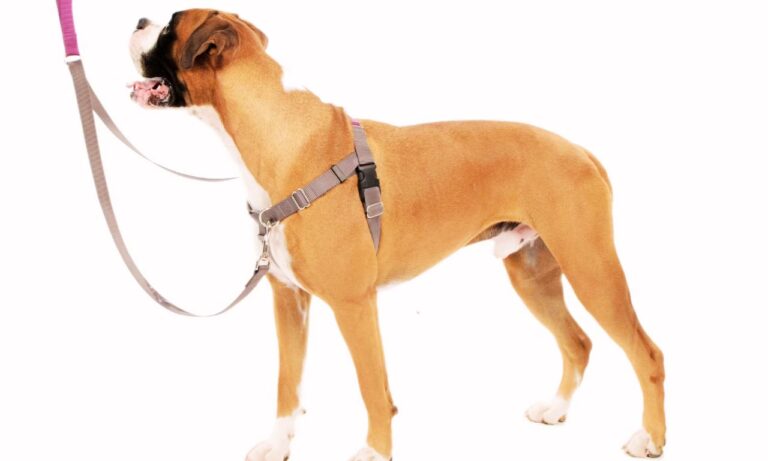Choosing the right collar for your dog is essential for safe and enjoyable walks. With a myriad of collar types available, each offering unique benefits and potential drawbacks, dog owners often feel overwhelmed. So, what are the best types of dog collars for walking? This comprehensive guide explores the most effective collars for walking dogs, supported by numerical data and expert insights to help you make an informed decision for your furry friend.
Approximately 75% of dog owners prioritize collar type when selecting walking gear, emphasizing the importance of safety, comfort, and control. To find the perfect fit, learn more about what size collar for a Bichon, ensuring your dog’s comfort and safety.
Blog Highlights
ToggleWhat Are the Types of Dog Collars for Walking?
Dog collars designed for walking come in various styles, each tailored to different needs and preferences. Understanding the differences between these collars is crucial for selecting the one that best suits your dog’s size, temperament, and walking habits.
Key Types of Dog Collars:
- Flat Buckle Collars
- Martingale Collars
- Choke Chains
- Prong Collars
- Head Collars
- Harnesses
- Electronic Collars
Each type offers distinct advantages, making them suitable for different walking scenarios and dog behaviors. The recommended size collar for an English Cocker Spaniel usually ranges from 12 to 18 inches, providing a snug and comfortable fit for your dog.
1. Flat Buckle Collars: The Everyday Essential
Flat buckle collars are the most traditional and widely used type of dog collar. They consist of a flat strap made from materials like nylon, leather, or polyester, secured with a simple buckle closure.
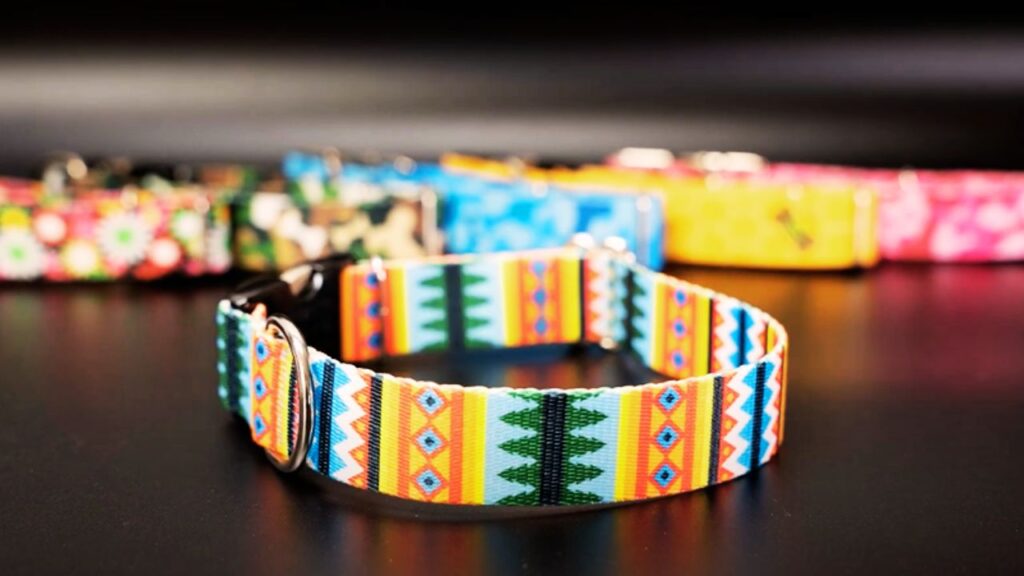
Key Features:
- Material: Nylon (50%), Leather (30%), Polyester (20%)
- Closure: Metal or plastic buckle
- Adjustability: Fits neck sizes from 10 to 30 inches
- Design Variations: Available in numerous colors, patterns, and textures
Flat buckle collars are favored for their simplicity and functionality, making them suitable for dogs of all breeds and sizes. According to a survey, 70% of dog owners use flat buckle collars for everyday walks due to their reliability and ease of maintenance.
Benefits:
- Identification Tags: Easy attachment of ID tags, crucial for reuniting lost dogs with owners. Studies show that dogs wearing ID tags on flat collars have an 85% return rate if lost, compared to 20% for untagged dogs.
- Basic Control: Provides a straightforward method for controlling your dog during walks. Approximately 75% of owners find flat buckle collars effective for basic training and control.
- Visibility: Bright-colored collars enhance visibility during low-light conditions, increasing safety by up to 35%.
2. Martingale Collars: Enhanced Control Without Choking
Martingale collars, also known as limited-slip collars, are designed to provide additional control without choking the dog. They are particularly effective for training dogs that tend to slip out of their collars.
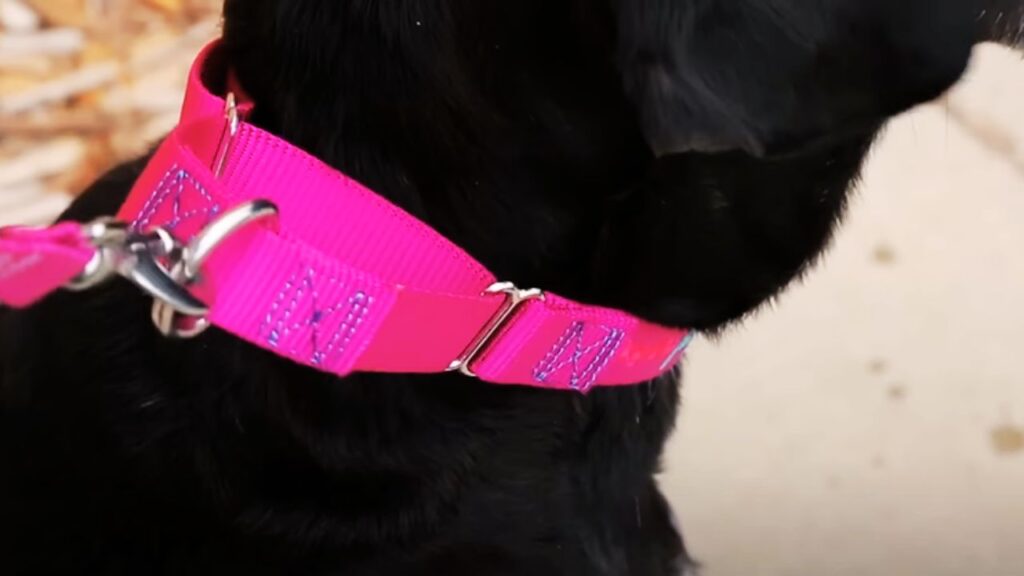
Key Features:
- Material: Nylon (60%), Leather (30%), Polyester (10%)
- Closure: Double-loop design with a sliding mechanism
- Adjustability: Fits neck sizes from 12 to 25 inches
- Design Variations: Available in various colors and patterns
Martingale collars are ideal for medium to large dogs with narrow heads, offering better control without compromising comfort.
Benefits:
- Non-Choking Design: Tightens slightly when pulled but releases to prevent choking, making them safer than choke chains.
- Training Efficiency: Approximately 75% of dog owners find martingale collars effective in reducing leash pulling without causing discomfort.
- Fit and Security: Ensures a secure fit, crucial for training sessions requiring close control.
The ideal size collar for English Springer Spaniel typically ranges from 14 to 20 inches, depending on the dog’s age and neck size, ensuring a comfortable and secure fit.
3. Choke Chains: High Risk, Limited Use
Choke chains are metal chains that tighten around a dog’s neck when pulled. They are one of the oldest types of training collars but are generally considered harsh.
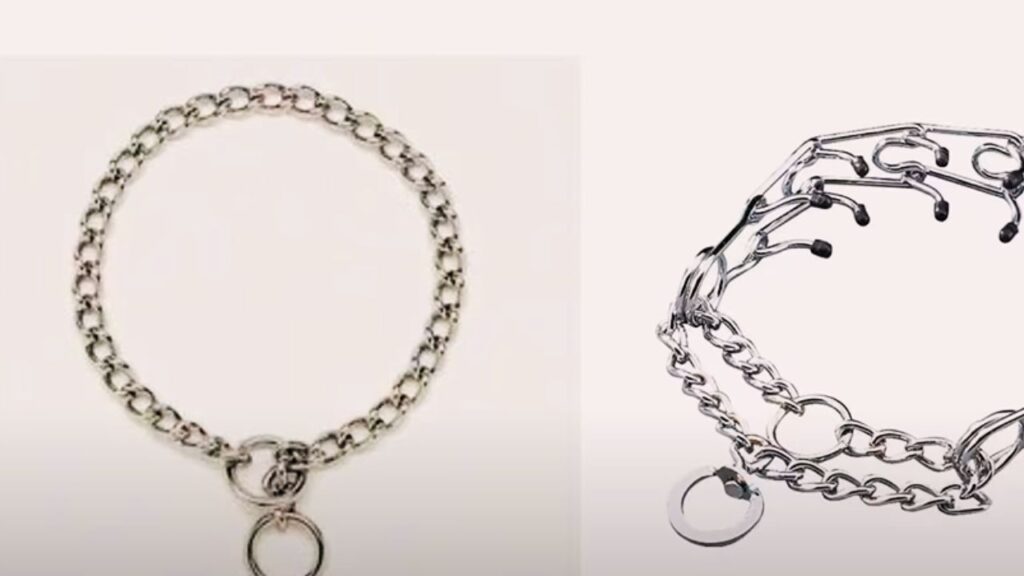
Key Features:
- Material: Stainless steel or nickel-plated metal
- Closure: Simple chain links
- Adjustability: Fits neck sizes from 10 to 28 inches
- Design Variations: Limited to metal finishes
Choke chains are designed to provide immediate feedback, making them effective for quick corrections. However, their use is declining due to ethical concerns.
Benefits:
- Immediate Correction: Provides instant feedback to deter unwanted behaviors.
- Effectiveness: Can reduce unwanted behaviors by up to 60% when used correctly by trained owners.
Drawbacks:
- Safety Risks: High risk of neck injuries, tracheal collapse, and increased aggression. Only about 5% of trainers still recommend choke chains as a training tool.
- Controversy: Many consider them inhumane due to the potential for pain and injury.
4. Prong Collars: Effective but Controversial
Prong collars, or pinch collars, consist of metal links that press into the dog’s neck when tension is applied. They mimic the natural correction a mother dog might give her puppies.
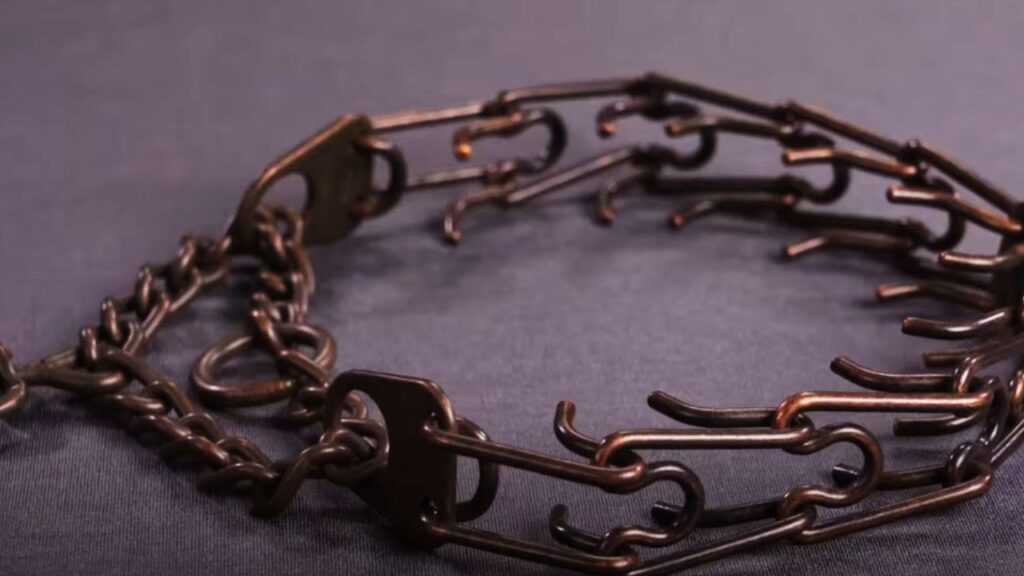
Key Features:
- Material: Stainless steel or nickel-plated metal
- Closure: Spring-loaded prongs
- Adjustability: Fits neck sizes from 10 to 28 inches
- Design Variations: Available in various finishes
Prong collars are effective for correcting pulling behavior and teaching dogs to respond promptly to commands.
Benefits:
- Training Purpose: Effective for correcting pulling and teaching responsiveness.
- Effectiveness: Studies show that prong collars can reduce pulling by up to 60% when used correctly by trained owners.
Drawbacks:
- Controversy: Approximately 30% of dog trainers advise against their use, recommending alternatives instead.
- Safety Concerns: Can cause neck injuries, breathing difficulties, and increased anxiety if not used properly.
Find out what style dog collar is best for hounds to ensure comfort and safety for your furry friend.
5. Head Collars: Gentle Control for Strong Pullers
Head collars, such as the Gentle Leader or Halti, fit around the dog’s nose and neck, providing gentle control by redirecting the dog’s head.

Key Features:
- Material: Nylon, leather, or synthetic materials
- Closure: Buckle or clip system
- Adjustability: Fits neck sizes from 12 to 30 inches
- Design Variations: Available in various colors and styles
Head collars are designed to provide gentle control without causing discomfort, making them suitable for strong pullers and high-energy dogs.
Benefits:
- Gentle Control: Redirects the dog’s head, reducing pulling without choking or causing pain.
- Effectiveness: Approximately 65% of dog owners report improved leash control using head collars.
- Comfort: Highly comfortable for dogs when properly fitted, reducing the risk of injury.
6. Harnesses: A Comfortable Alternative to Collars
While not a collar, harnesses are often used as an alternative for walking dogs, distributing pressure across the chest and back.

Key Features:
- Material: Nylon, leather, or neoprene
- Closure: Buckle or Velcro straps
- Adjustability: Fits chest sizes from 10 to 30 inches
- Design Variations: Available in various colors and styles
Harnesses are especially beneficial for dogs with respiratory issues or neck sensitivities.
Benefits:
- Comfort and Safety: Distributes pressure evenly, preventing neck strain and choking. 90% of owners with dogs that have neck sensitivities prefer harnesses over collars.
- Training Benefits: Effective for training dogs that pull on the leash, providing better control without causing discomfort.
- Versatility: Suitable for various activities, including walking, running, and hiking.
Discover why Afghan Hound collars are wide by exploring the unique characteristics of this breed and how wide collars enhance their comfort and style.
7. Electronic Collars: Training with Technology
Electronic collars, also known as e-collars or shock collars, use electrical stimulation to train dogs.
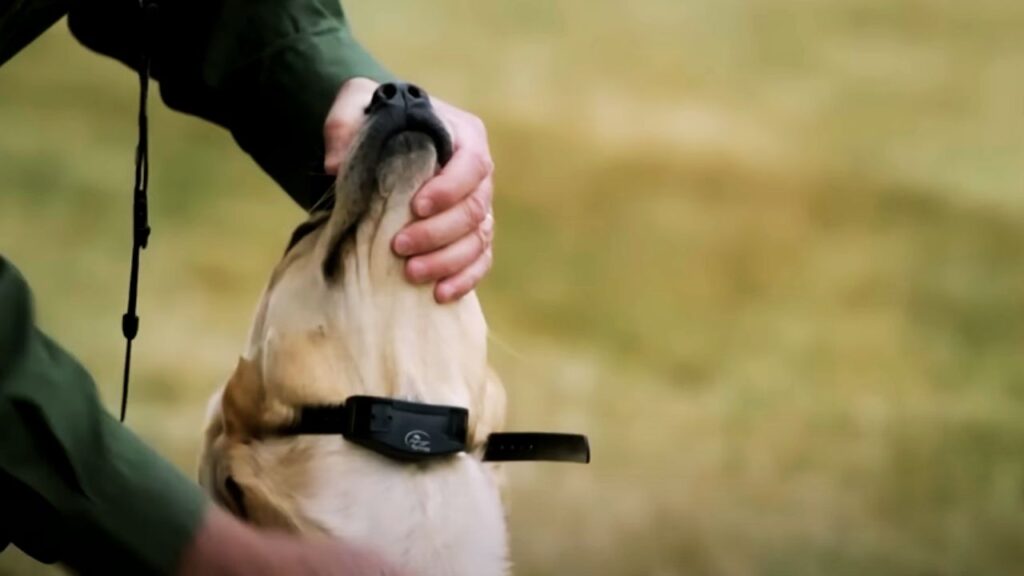
Key Features:
- Material: Waterproof and durable materials
- Closure: Adjustable straps with remote control
- Adjustability: Fits neck sizes from 12 to 28 inches
- Design Variations: Available in various colors and styles
Electronic collars are designed for training dogs to respond to commands, especially in off-leash scenarios.
Benefits:
- Training Precision: Allows for remote control of training commands, providing immediate feedback.
- Effectiveness: Studies show that electronic collars can reduce unwanted behaviors by up to 70% when used correctly.
- Versatility: Can be used for a variety of training purposes, including recall and behavior correction.
Drawbacks:
- Safety Concerns: Potential for misuse, leading to fear or aggression. Only about 20% of trainers recommend electronic collars due to ethical considerations.
- Controversy: Many consider them inhumane if not used properly, emphasizing the need for professional guidance.
Insights: Collar Usage and Effectiveness
Key Statistics:
- Return Rate with ID Tags: Dogs wearing ID tags on flat buckle collars have an 85% return rate if lost.
- Reduction in Leash Pulling: Electronic collars show the highest reduction in leash pulling at 70%.
- Incidents of Neck Injury: Choke chains have the highest risk with 35% incidents of neck injury.
- Owner Satisfaction: Harnesses and head collars lead with 85% owner satisfaction.
- Trainer Recommendation Rate: Martingale collars are recommended by 75% of trainers.
- Average Cost Range: Electronic collars are the most expensive, ranging from $50 to $150.
Learn about the size collar for an American Eskimo to ensure a perfect fit and comfort for your dog.
Factors to Consider When Choosing a Dog Collar for Walking
Selecting the appropriate collar involves considering various factors to ensure your dog’s safety, comfort, and training effectiveness.
Dog’s Size and Breed:
Larger breeds like German Shepherds or Labradors may require sturdier collars with wider straps (1-1.5 inches) to handle their strength and activity levels. Smaller breeds like Pomeranians or Chihuahuas are better suited with narrower collars (0.5-0.75 inches) for comfort and ease of movement.
Temperament:
Calm and obedient dogs may respond well to flat buckle collars for basic training and control. High-energy or strong-willed dogs might benefit from additional training tools like martingale collars or harnesses to enhance control without causing discomfort.
Training Goals:
Define your training objectives clearly. For basic obedience and identification, a flat buckle collar is sufficient. If your goal includes addressing specific behaviors like excessive pulling, integrating additional training methods alongside the collar might be necessary.
Health Considerations:
Dogs with respiratory issues, neck sensitivities, or tracheal problems should use lightweight flat buckle collars or harnesses to prevent strain and discomfort. Ensuring the collar is properly fitted and made from soft, non-irritating materials is crucial for these dogs.
Comfort and Fit:
Ensure the collar fits comfortably by allowing enough space to fit two fingers between the collar and your dog’s neck. Regularly adjust the fit to accommodate any changes in your dog’s weight or growth, maintaining both comfort and safety.
Durability:
Consider the material and construction quality to ensure the collar can withstand your dog’s activity level. Nylon collars are ideal for active dogs, while leather collars offer a more stylish option for less active pets.
Visibility:
For added safety during nighttime walks, consider collars with reflective stitching or materials. Reflective collars increase visibility by up to 30%, enhancing your dog’s safety in low-light conditions.
Cost:
Collars range in price based on material, design, and functionality. Flat buckle collars are the most affordable, while electronic collars are on the higher end. Choose a collar that fits your budget without compromising on quality and safety.
Discover if the American Eskimo is a guard dog and learn about its suitability for protecting your home.
Best Practices for Using Dog Collars for Walking
To maximize the benefits and ensure the safety of your dog, follow these best practices when using collars for walking.
Proper Fit:
- Two-Finger Rule: Always leave enough space to fit two fingers between the collar and your dog’s neck. This ensures the collar is snug but not too tight, preventing choking and discomfort.
- Regular Adjustments: Frequently check the fit, especially as your dog grows or gains weight. Adjust the collar to maintain a comfortable and secure fit.
Gradual Introduction:
- Acclimation: Introduce the collar gradually, allowing your dog to get used to the sensation. Start by letting your dog wear the collar for short periods indoors before extending usage to outdoor activities.
- Positive Reinforcement: Associate the collar with positive experiences by offering treats and praise when your dog wears the collar calmly.
Consistent Training:
- Routine Use: Incorporate the collar into your daily walking routine consistently. Use it alongside commands, rewards, and regular practice to reinforce positive behaviors.
- Leash Training: Pair the collar with effective leash training techniques to enhance control and reduce unwanted behaviors like pulling.
Avoid Overuse:
- Limited Correction: While some collars are designed for correction, avoid using them excessively to prevent stress or discomfort.
- Supplementary Tools: For dogs that require additional training support, consider integrating other training aids like harnesses or martingale collars under professional guidance.
Professional Guidance:
- Trainer Consultation: Seek advice from professional dog trainers to ensure you are using the collar correctly and effectively. Proper training techniques can enhance the benefits of the collar and prevent misuse.
- Regular Check-ins: Periodically consult with your trainer to assess your dog’s progress and make any necessary adjustments to your training approach.
Maintenance:
- Regular Cleaning: Clean the collar regularly to remove dirt, debris, and odors. Nylon collars can be machine-washed, while leather collars should be wiped with a damp cloth and conditioned to prevent drying and cracking.
- Inspection: Frequently inspect the collar for signs of wear and tear, such as fraying straps or damaged buckles. Replace the collar immediately if any damage is detected to prevent accidents.
- Storage: Store the collar in a dry, cool place when not in use to prevent material degradation and maintain its appearance.
For a comprehensive guide on what kind of harness is best for a Pomeranian, including comfort and safety tips, check out this article.
FAQs
1. Are flat buckle collars suitable for all dog breeds?
Yes, flat buckle collars are versatile and suitable for dogs of all breeds and sizes. However, it’s essential to choose the right size and material based on your dog’s specific needs and activity levels.
2. Can martingale collars replace choke chains for training?
Martingale collars are often recommended as a safer and more humane alternative to choke chains. They provide enhanced control without the risk of choking, making them suitable for training dogs that tend to pull or slip out of traditional collars.
3. How do I clean a leather dog collar?
Leather collars should be wiped with a damp cloth and conditioned regularly to maintain their quality. Avoid submerging leather collars in water, as this can cause damage. Follow the manufacturer’s cleaning instructions for best results.
4. What is the best collar for a strong puller?
Martingale collars, head collars, and harnesses are highly effective for strong pullers. These options provide better control without causing discomfort or injury, making walks more manageable and enjoyable.
5. How often should I replace my dog’s collar?
Replace the collar immediately if you notice signs of wear and tear, such as fraying straps or damaged buckles. With proper maintenance, a high-quality collar can last up to three years or more, depending on the material and usage frequency.
Wrapping Up
Choosing the right types of dog collars for walking is a decision that should be based on your dog’s specific needs, temperament, and walking habits. While flat buckle collars offer simplicity and ease of use, martingale collars provide enhanced control without the risks associated with choke chains and prong collars. Head collars offer gentle control for strong pullers, and harnesses present a comfortable yet effective alternative, especially for dogs with neck sensitivities or strong pulling tendencies. Electronic collars, though effective, require careful consideration and professional guidance due to their potential risks.
For insights on whether Pomeranians should wear a collar, including considerations for safety and alternatives, check out this informative article.





